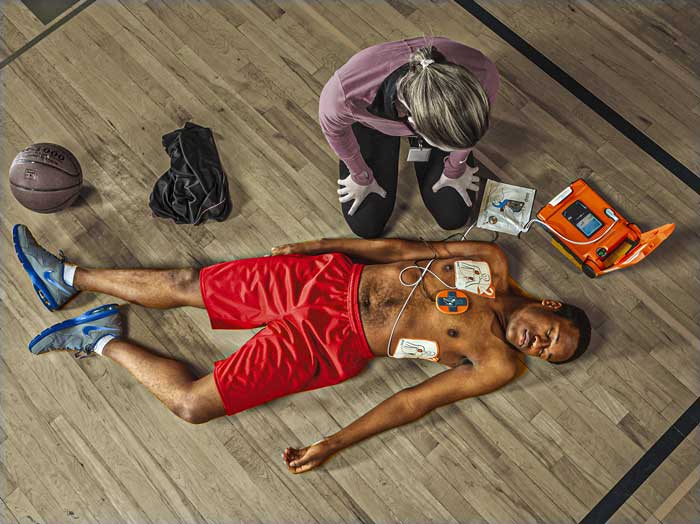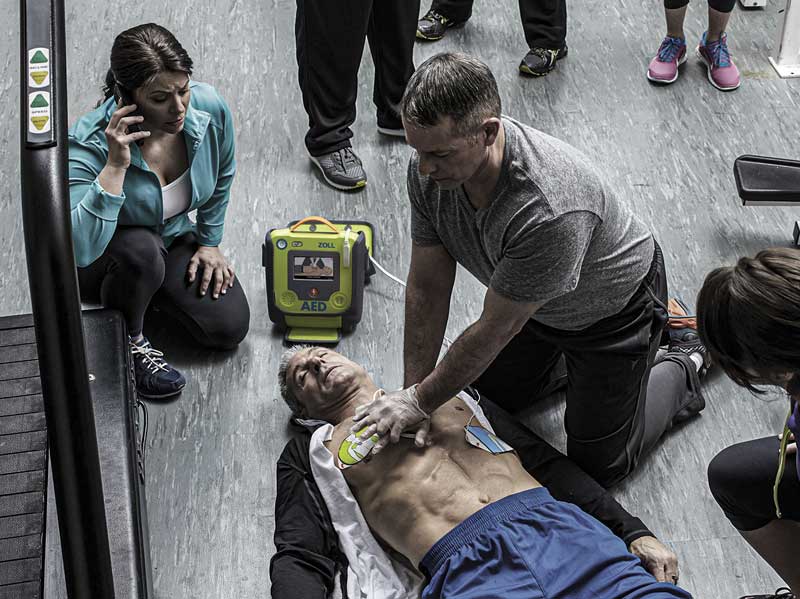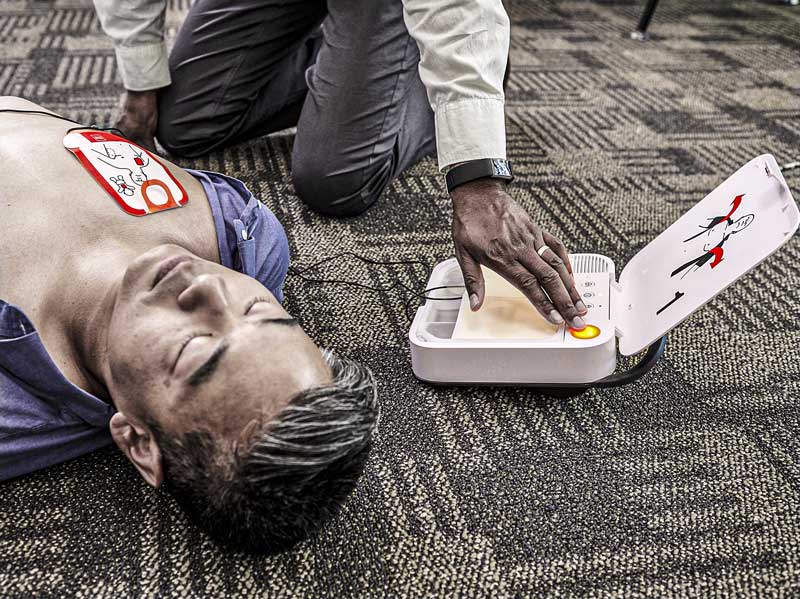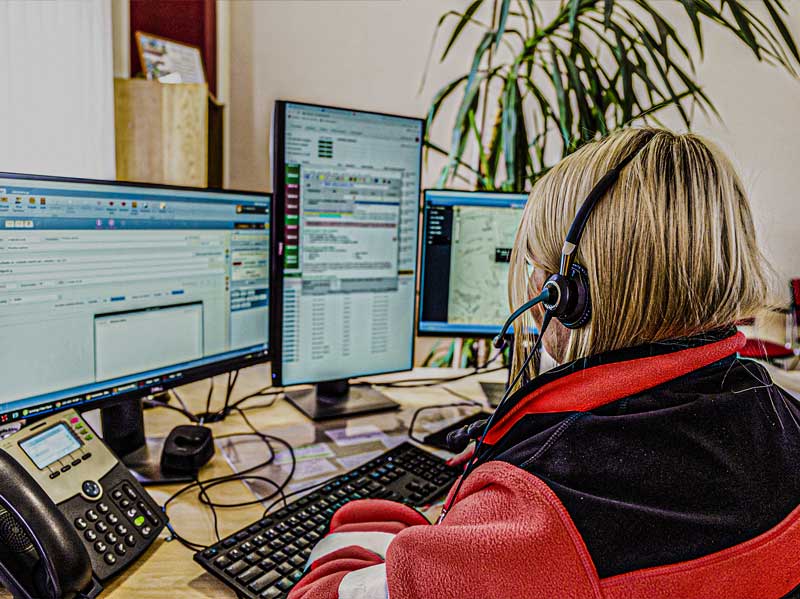Overview of Responding
- Step One:
- Scene Safety. If someone appears unresponsive, there is a chance something in the surrounding area caused an accident or harmed them in some way.
Check for dangers such as heat/smoke, liquids, or unusual odors. DO NOT ENTER THE SCENE if any dangers are present. If any dangers are present, call 911.
- Scene Safety. If someone appears unresponsive, there is a chance something in the surrounding area caused an accident or harmed them in some way.
- Step Two:
- If the scene is safe, approach the victim from the side and check for responsiveness by tapping their shoulder and shouting. If they do not respond, have a bystander call 911 and go get an AED.
If you are alone, Call 911 and get an AED and return to the victim.
- If the scene is safe, approach the victim from the side and check for responsiveness by tapping their shoulder and shouting. If they do not respond, have a bystander call 911 and go get an AED.
- Step Three:
- Begin CPR immediately. Continue CPR until the AED arrives, help arrives, or you are too tired to continue.
As soon as the AED is available, turn on the AED (or lift the lid), apply the pads, and follow the voice instructions.
- Begin CPR immediately. Continue CPR until the AED arrives, help arrives, or you are too tired to continue.
CPR (Cardiopulmonary Resuscitation)
Adult CPR
When a person is unresponsive and not breathing, make sure they are face up on a firm, flat surface. Immediately begin hands-only CPR by:
- Place the heel of one hand in the middle of the chest between nipples. Clasp your other hand on top and pull fingers upward. ·
- Press hard and fast. Press at least 2” deep, at a rate of between 100 and 120 beats per minute
- Allow the chest to fully rise between each compression. Do not stop until help arrives or the AED tells you to stop.
Integrating CPR and AED Use
It is very important to reduce any interruptions to CPR. If a bystander arrives with an AED, DO NOT STOP CPR. Take the following actions:
- Turn on the AED
- The AED user should remove or cut clothing from the chest.
- Apply the pads around the hands of the person performing CPR. Once the AED pads are in place, stop CPR.
Follow all AED prompts.The person using the AED and the person performing CPR should change places every time the AED re-analyzes, which is every 2-minutes.
Using Your AED
Using an AED is perhaps the simplest part of any cardiac emergency.
AEDs are designed to be easy-to-use by people with little-to-no training whatsoever.
All AEDs operate with the same basic premise:
- Turn on the AED.
- Follow AED Prompts
- If shock advised, deliver shock.
- Resume CPR
AEDs are Safe and Easy to Use!
Know your AED! What type of AED do you have?
- A semi-automatic AED is an AED that will prompt a user to clear the victim and deliver a shock.
A verbal prompt can be accompanied by an audible alert, flashing lights, text and/or video instructions.
Once the victim is clear, deliver the shock by pressing the flashing shock button. - A fully-automatic AED is an AED that will deliver the shock when it is safe and appropriate to do so.
With added safety measure such as motion detection, it is vital that you keep the area clear once the AED begins the countdown to deliver a shock.
Good Samaritan & Legal
If All 50 states and D.C. include using an AED and CPR in their Good Samaritan laws. Good Samaritan coverage varies by state, but the common principles are the same nationwide.
If you assist someone with good intent, do not accept money or other payment for helping, keep their information private and try not to treat beyond your scope of training, you will be protected by the Good Samaritan Act. For more information, read your state’s specific Good Samaritan law.
Requirements
Protection under the Good Samaritan Law normally requires:
- No compensation given for assistance
- Respond voluntarily
Provide care within good intention and good faith
- Do not abandon the victim. Once you decide to help, do not leave the victim until help arrives.
Gaining Consent
Always gain consent before beginning care. Normally this is done verbally – by asking the person if you can help and that person either nodding or verbally confirming.
In the case of an unresponsive victim, implied consent is given. Implied consent is assumed when a person is unresponsive or mentally incoherent and unable to answer.
For CPR/AED use, implied consent was granted when you tapped and shouted on the victim’s shoulder and did not receive a reply.
After an Emergency

Report AED use to your local EMS Authority
Often times this is done by your local ambulatory agency when the paramedics take over care.
Other times it is necessary for you to contact the EMS authority in your county to report use.
If your county has any further reporting requirements, they will advise you once you notify them.
Contact AED.US
The experts at AED.us will guide you through everything you need to put your AED back in service.
This may consist of downloading/clearing data off of your AED, replacing pads and potentially replacing the battery.
As soon as you’re able, place your AED back in service.
Talk to your staff/family
Emergent situations are stressful for everyone involved, no matter the outcome.
Talk to your staff, family or anyone else present during the emergency.
Discuss what went right, how they feel, and find a source for post-event trauma counseling if needed.
